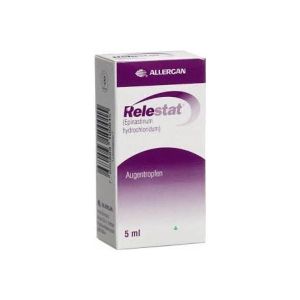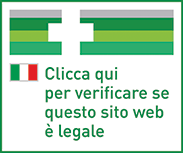Ship in Europe, Find out rates!
Relestat Collirio Epinastina Flacone 5 ml

- box Delivery in Italy in 24/48 and free returns
- star3.000+ positive reviews
- dropboxOver 60,000 products in the catalog
Eye drops based on epinastine hydrochloride.
Therapeutic indications
Relestat Collirio is used in the symptomatic treatment of seasonal allergic conjunctivitis.
Dosage and Posology
The drug should be taken according to the following doses and methods: in adults the recommended dose is one drop instilled in each affected eye twice a day, during the symptomatic phase. There are no clinical trial data available on the use of Relestat for longer than 8 weeks.
Relestat has not been studied in older people. Post-marketing data on the safety of epinastine hydrochloride tablets (administered once daily up to a dose of 20 mg) indicated that there are no particular safety concerns in older people compared to adult patients. For this reason, no dosage adjustment is considered necessary.
The safety and efficacy in children aged ≥ 12 years have been established in clinical studies. Relestat can be used in adolescents (12 years and older) at the same dosage as for adults. The safety and efficacy of Relestat in children aged less than 3 years have not been established. No data are available. There are limited data on safety in children 3 to 12 years of age.
The use of Relestat has not been studied in patients with hepatic impairment. Post-marketing data on the safety of epinastine hydrochloride tablets (administered once daily up to a dose of 20 mg) indicated a higher incidence of adverse reactions in this patient group than in adult patients with no hepatic impairment. The daily dose of one 10 mg epinastine hydrochloride tablet is more than 100 times the recommended daily dose of Relestat. Furthermore, the metabolism of epinastine is minimal in humans (<10%). For this reason, no dosage adjustment is considered necessary.
The use of Relestat has not been studied in patients with renal impairment. Post-marketing data on the safety of epinastine hydrochloride tablets (administered once daily up to a dose of 20 mg) did not indicate any particular safety concerns in patients with renal impairment. For this reason, no dosage adjustment is considered necessary.
Relestat is for topical ophthalmic use only. To avoid contaminating the eye or eye drops, the dropper tip must not come into contact with any surface. In the case of use of several topical ophthalmic products, the different medicines must be administered at least 10 minutes apart from each other.
Overdose
Following instillation of 0.3% epinastine hydrochloride eye drops, three times a day (corresponding to a dosage 9 times the recommended daily dosage) cases of reversible miosis have been observed, with no influence on visual acuity or on other ocular parameters. The 5 ml bottle of Relestat contains 2.5 mg of epinastine hydrochloride. Tablets containing up to 20 mg of epinastine hydrochloride to be taken once a day are marketed and, consequently, the possibility of intoxication due to oral ingestion, even after ingesting the entire vial, is not anticipated. No cases of overdose have been reported
Contraindications
Hypersensitivity to the active substance or to any of the excipients.
Side effects
In clinical trials, the overall incidence of side effects related to the use of Relestat was less than 10%. No cases of serious side effects have been reported. Most of the cases were minor eye disorders. The most common side effect reported was a burning sensation in the eye (mostly mild); all other side effects were uncommon. Within each frequency class, the undesirable effects are reported according to the System Organ Class in decreasing order of severity. The following terminologies have been used for the purpose of classifying the occurrence of undesirable effects: Very common (> 1/10); common (> 1/100 to <1/10); uncommon (> 1/1000 to <1/100); rare (> 1/10000 to <1/1000); very rare (<1/10000), not known (cannot be estimated from the available data). The following side effects have been reported in clinical trials with Relestat:
- Nervous system disorders
- Uncommon: headache
- Eye disorders
- Common: burning sensation / eye irritation
- Uncommon: conjunctival / ocular hyperaemia, ocular discharge, dry eye, ocular pruritus, visual disturbances, lacrimation increased *, eye pain *.
- Respiratory, thoracic and mediastinal diseases
- Uncommon: asthma, nasal irritation, rhinitis
- Gastrointestinal disorders
- Uncommon: dysgeusia.
* Increased lacrimation and eye pain have been reported during post-marketing use of Relestat in clinical practice.
The frequency, type and severity of adverse reactions in adolescents aged ≥ 12 years are the same as expected in adults. There is limited experience in children aged 3 to 12 years with regard to the frequency, type and severity of adverse reactions.
Cases of corneal calcification associated with the use of phosphate-containing eye drops have been reported very rarely in patients with severe corneal impairment.
Pregnancy and breastfeeding
Data on a limited number (11) of pregnant women indicate that there are no adverse effects related to the use of epinastine in pregnancy or on the health of the fetus / newborn. To date, no other relevant epidemiological data are available. Animal studies have not indicated direct or indirect harmful effects with respect to pregnancy, embryonic / fetal development, parturition or postnatal development. Prescribing of the drug to pregnant women should be done with caution.
Epinastine is excreted in rat milk but it is not known whether it is excreted in human milk. Given the lack of experience, the prescription of the drug to breastfeeding women should be done with caution
Special warnings
Relestat is for topical ophthalmic use only and not for injectable or oral use. Benzalkonium chloride is commonly used in ophthalmic products as a preservative; Cases of punctate keratitis and / or toxic ulcerative keratopathy have been reported rarely. Benzalkonium chloride can be absorbed by soft contact lenses and cause discoloration: patients should therefore be advised to wait at least 10-15 minutes after administration of Relestat before applying contact lenses. Relestat should not be given while wearing contact lenses.
Expiration and retention
Check the expiration date indicated on the package. The expiry date indicated on the package refers to the product in intact packaging, correctly stored. Keep the bottle inside the box to protect the product from light. Store at a temperature not exceeding 25 ° C.
Warning : do not use the medicine after the expiry date indicated on the package.
Composition
1 ml of Relestat Eye Drops contains:
Active principle
0.5 mg of epinastine hydrochloride
Excipients
Benzalkonium chloride, Disodium edetate, Sodium chloride, Sodium dihydrogen phosphate dihydrate, Sodium hydroxide / hydrochloric acid (to adjust the pH), Purified water.


